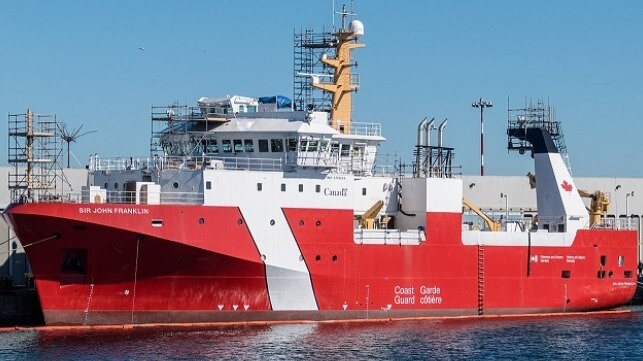Canadian Coast Guard's Three New Fishery Vessels Drydocked for Repair
The Canadian Coast Guard has found that its new series of marine science vessels have a "class-wide" issue with premature failure of their stern tube bearings, according to CBC, requiring all three hulls to be drydocked and repaired. CCGS
Sir John Franklin and CCGS
John Cabot have already been refitted, and CCGS
Jacques Cartier is due for a propeller shaft bearing replacement next month.
"As any new ship enters full operation, there may be some issues that need to be addressed and we continue to work closely with our customer, ready to provide support and assistance if and as required," a spokesperson for the shipbuilder told CBC.
The vessels were designed and built under Canada's National Shipbuilding Strategy (NSS), and the need for an early refit is the latest in a string of delays, cost overruns and setbacks for the program.
The NSS shares contracts among three Canadian shipyards for all government vessel procurement, including the Canadian Surface Combatant, a frigate for the Royal Canadian Navy; an Arctic Offshore Patrol Vessel, for both the Royal Canadian Navy and the Canadian Coast Guard; a new class of heavy icebreakers for the Canadian Coast Guard; the Offshore Fishery Science Vessels; and a variety of other support and non-combatant vessels.
The cost estimate for the frigate has skyrocketed to more than $3 billion per hull, nearly twice the price of a larger
Arleigh Burke-class destroyer, and the price of the next two Arctic Offshore Patrol Ships for the Canadian Coast Guard has doubled to $600 million each.
The future icebreaker faces two challenges. The cost for each vessel in the two-hull series has risen to nearly $3 billion, roughly three times the unit cost for the U.S. Coast Guard's Polar Security Cutter heavy icebreaker program.
In addition, according to the Ottawa Citizen, the shipbuilder may have difficulty in sourcing the specialized LR EH50 high-strength steel specified for the construction of the vessels' hulls. The Canadian Coast Guard listed steel availability at the top of the list of its concerns for the program in response to questions from Canada's House of Commons. The market for structural steel has been stretched thin by demand shocks related to the COVID-19 pandemic, and the NYSE Steel Index benchmark price has doubled since 2020.
The Canadian Coast Guard has found that its new series of marine science vessels have a class-wide i...

www.maritime-executive.com



